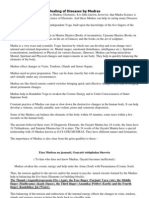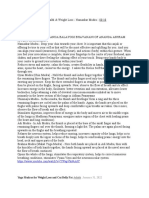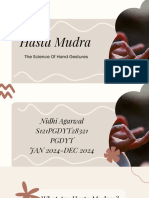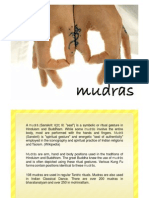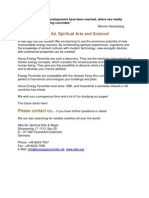Continue
Continue
Uploaded by
कालीपुत्रCopyright:
Available Formats
Continue
Continue
Uploaded by
कालीपुत्रOriginal Title
Copyright
Available Formats
Share this document
Did you find this document useful?
Is this content inappropriate?
Copyright:
Available Formats
Continue
Continue
Uploaded by
कालीपुत्रCopyright:
Available Formats
Continue
399 mudras pdf
Mudra is a Sanskrit word. ‘Mud’ means joy and ‘Ra’ means produce. Thus, the word Mudra means an action or activity done for producing delight. Originally mudras were used by the Hindus for rituals. Each ritual has its own significance and scientific denotation. Mudra helps relaxation and deep
meditation. Therefore, we see all Hindu Gods and Goddesses sitting in some form of mudras. Mudras are a silent language of self-expression. Practicing mudra is very easy; in fact, and do not call for any restrictions. They are postures or gestures with fingers during meditation to open, release, or close
the flow of internal energy according to your requirement. Because of its psycho-energetic effects, they are powerful for sending messages to the nerve endings in our hands to the brain. In Mudra practice, the body communicates with the mind; because mind and body are interconnected in a vital unity. It
is estimated that around 399 different mudras are accessible, 36 being the most practiced ones. Mudras are credited for therapeutic or curative powers of the mind and body. They help to link the brain to the body, soothe pain, stimulating the endorphin system, change the mood and increase our vitality.
However, their degree of effectiveness depends not only on the frequency or regularity of practice, but also, among other factors, the quality of the diet, eating habits and life in general. These practices are performed by people of all religions, cast and creed for relaxation and advancement in meditation.
These techniques are 100% compatible with any philosophy, ideology or belief, as the main purpose of these gestures is to reach a body-mind energy connection. Its practice is not difficult; you only need to stay focused on gestures. To practice the Mudras one does not require great skills, it requires
regularity, few minutes a day. For beginners, it is advisable to choose a quiet place where no one interrupts us, away from noise and preferably alone and in silence. Once you have mastered the art, the practice can be performed elsewhere. Mudras can be practiced as per our own needs. We can make
a specific Mudra to relieve uneasiness or help cure a particular disease. A daily practice of Mudras contributes to improving and strengthening of our physical, emotional, mental and spiritual achievement. There are a few Mudras to overcome any ailments. They are as follows: Gyan Mudra: Touch the tip
of your index finger with the tip of your thumb. The other three fingers may be kept straight or just keep it free, doesn’t matter even if they are slightly bent. This is a very commonly used Mudra when practicing meditations. The benefits of this Mudra are: As the name suggests, this Mudra is meant to
increase your concentration and memory power. This Mudra sharpens your brain power. It has the ability to cure insomnia. Practice this Mudra regularly to heal yourself of all mental and psychological disorders like anger, stress, anxiety or even depression. Surya Mudra: This mudra is formed by placing
the tip of the ring finger on the base of the thumb and applying mild pressure of the thumb on the finger. Surya or Sun signifies fiery energy. Surya Mudra increases fire element in the body. This Mudra helps in cutting the fat and lowering bad cholesterol (Low Density Lipoproteins). Surya mudra is
beneficial for eyes. It is excellent for people with high Kapha constitution (heavy, slow, laid back attitude, excess mucous). The mudra helps Kapha type by increasing alertness and mobility. The mudra is helpful for people who have intolerance to cold and encounter frequent shivering. Do as required for
10-15 minutes. Prana Mudra: Join thumb with little and ring fingers and let the magic begin. The Pran Mudra increases vitality, reduces fatigue and nervousness, and improves vision. It is also used against eye diseases. The food we eat is the source of prana. The reservoir battery is charged with the
energy provided by food we eat. However, modern living lets prana exhausted due to incessant flow from sense organs. Our eyes that are glued to computer/TV screens, we are restless; our continuous involvement in futile activities such as not eating healthy foods, no rest, less sleep depletes the prana
reserves. Prana mudra restores our energy reserves. Make sure you do it for minimum of 15 minutes every day. Vayu Mudra: This mudra is formed by first placing the tip of the index finger on the base of the thumb and then bringing gentle pressure of the thumb upon this finger. This amounts to
suppression of element air (residing in the first finger) by element fire (residing in the thumb). Vaayu mudra decreases the air element within the body. This reduction of air sedates restless and anxious mind. Calms overcharged nervous system, pacifies overactive endocrine glands, relaxes tense or
spastic muscles, soothes strained voice, and allows re-hydration of skin and particular cartilage. The element air is also a component of bodily humor Vaata. This mudra is especially suitable for people of Vaata constitution (Vaata dosha). They can regularly use this mudra even to avoid illness. Prithivi
Mudra: This mudra is formed by joining together the tips of the ring finger and the thumb. The element earth is a vital component of bodily tissues like bones, cartilage, skin, hair, nails, flesh, muscles, tendons, internal organs, etc. Practice of Prithvi-vardhak mudra builds and revitalizes these tissues. In
other words, this mudra increases vitality, strength and endurance. The element earth is also associated with the nose (smell). Therefore, Prithvi-vardhak mudra can be used to overcome nasal disorders (e.g., loss of sense of smell). The element earth is also a component of the bodily humor kapha.
Practice of Prithvi-vardhak mudra increases the kapha humor within the body. Therefore, this mudra can be used to overcome disorders caused by kapha deficiency. However, it should be practiced in moderation by people who already have an excess of kapha in their bodies. This mudra helps eliminate
chronic fatigue, general debility, convalescence, lack of stamina or endurance Inexplicable weight-loss and emaciation. They help expedite fractures. Varun Mudra: This mudra is formed by joining together the tips of the thumb and the little finger. Jal-vardhak (Varun) mudra increases the water element
within the body. Almost seventy per cent of the body is water. Thus, water is the most abundant element in the body, being present in the protoplasm of cells, extra-cellular fluid, lymph, blood, tears, saliva, mucous, digestive juices, enzymes, hormones, semen, cerebrospinal fluid (CSF), etc. A deficiency of
water in the body would result in dehydration of tissues. Performance of Jal-vardhak mudra increases the water-content of the body by suitably affecting the water-metabolism. Thus, it helps to rehydrate cells, tissues, muscles, skin, joint-cartilage, etc. The element water is also associated with tongue and
taste. Therefore, this mudra can be used to overcome disorders like loss of taste-sense, dryness of mouth, etc. Water is also a component of two bodily humors: Pitta and Kapha. Practice of Jal-vardhak mudra increases these humors. It cures dryness of eyes, dryness of the digestive tract (mouth, throat
and intestine, indigestion, constipation, dryness of the skin leading to cracks, dry eczema, psoriasis, etc. degeneration of joint-cartilage, osteo-arthritis, anemia, cramps, dehydration, and deficiency of hormones. Shunya Mudra: Keep the tip of middle finger at the top of Venus and press it with the thumb. It
is useful in getting rid of any ear problems because of heavy usage of mobile. Even if it is not ringing, you think it is ringing. It means your ear is not working properly. May be there will be a heavy sound – some form of humming sound in the ear. Any ear problem can be mitigated with this Mudra. This
Mudra is useful, when you are airborne. Your ear pains, while flying high altitudes. Cotton is used to mitigate this issue. Do this Mudra, and your ear pain will automatically come down. Apana Mudra: Place the thumb, middle finger, and ring finger together and extend the other fingers. Do it with both
hands. Apana governs the pelvis and abdomen and controls the eliminative functions of the body. The body eliminates the toxins through various methods. The release of carbon dioxide from lungs, cough and mucous from organs of respiration, perspiration from skin, excretion through intestine, urination
through kidneys and menstruation through hormonal cycle in females. Apana mudra helps by accelerating elimination. It helps in easy excretion, clears frontal sinus and removes phlegm from lungs. The mudra gives us patience, serenity, confidence, inner balance, and harmony. Akash Mudra: Join the tip
of the thumb with tip of middle finger. The other three fingers remain extended. Akash mudra counters absence of space in the body. Deficiency of space element weakens the heart and creates trouble in places associated with space. This includes ears and joints. Akash Mudra is beneficial for people
with heart ailments and related disorders like blood pressure. It strengthens the bones. It is also beneficial in vertigo and loss of balance. This mudra also increase spiritual power and makes the practitioner fearless. Some important rules for practicing Mudras: Comments This article includes a list of
general references, but it remains largely unverified because it lacks sufficient corresponding inline citations. Please help to improve this article by introducing more precise citations. (December 2016) (Learn how and when to remove this template message) This is a list of Yoga mudras. In yoga, mudrās
are used in conjunction with pranayama (yogic breathing exercises), generally while seated in Padmasana, Ardhasiddhasana, Sukhasana or Vajrasana pose, to stimulate different parts of the body and mind, and to affect the flow of prana in the body. It is believed that certain mudras have certain effects
on the body, and are thus used for healing purposes.[1] Research studies have been conducted that show a change in energy fields in persons practicing mudras for long periods of time.[2] Hasta Hasta mudras (hand mudras) may be conducive for meditation, and help in internalization. Many hand
mudrās evolved for use in rituals, especially within tantra. Others developed as iconographical symbols for depictions of deities in statues and paintings. Others were developed for non-verbal story telling in traditional dance. In the Hevajra Tantra hand mudrās are used to identify oneself to the goddesses
at different holy sites. Sanskrit English Other Meanings Description Anjali Mudra Gesture of reverence Offering; Prayer Palms touching, fingers pointing upward. May be placed in front of the sternum, the forehead, or overhead. Dhyana Mudra Psychic gesture of meditation Upturned hands overlapping
each other, usually right on top of left, with the thumbs touching. Vāyu Mudra Psychic gesture of air Tip of index finger on the ball of the thumb, with thumb over the bent finger. Other three fingers are extended. Shunya Mudra (or Shuni Mudra) Psychic gesture of void or empty Middle finger bent, with
thumb over it. Other three fingers are extended. Sometimes, tip of the bent finger on the ball of the thumb. Prithvi Mudra Psychic gesture of earth Ring finger bent, with thumb over it. Other three fingers are extended. Varuna Mudra Psychic gesture of Rain Little finger bent, with thumb over it. Other three
fingers are extended. Shakti Mudra Psychic gesture of power Tips of little and ring fingers of both hands touching, with middle and index fingers folded. Sometimes, thumb folded towards the palm. Hakini Mudra Hand-steepling or finger-tenting: joining matching fingertips of right and left hands.[3] Prāna
Mudra Psychic gesture to activate life force energy Tips of little finger and ring fingers touch thumb. Other two fingers are extended.[4] Apāna Mudra Psychic gesture of life force Tips of middle and ring fingers touch thumb. Other two fingers are extended. Poorna Mudra / Brahma Mudra Gesture of full
breath Thumb tucked in, placed at the base of the fingers. Remaining fingers curled over thumb, forming a fist. Hands are then tucked under the navel area, with fingers facing upwards, and back of the fingers touching. Gyana Mudra / Chin Mudra Psychic gesture of knowledge Tip of index finger touches
thumb, hand upturned. Other three fingers are extended. Jnana Mudra / Chin Mudra Psychic gesture of consciousness Tip of index finger touches thumb, hand overturned. Other three fingers are extended. Adi Mudra The first gesture (as held by a new born baby) Thumb tucked in, placed at the base of
the fingers. Remaining fingers curled over thumb, forming a fist. Chinmaya Mudra Pervaded by consciousness mudrā Tip of thumb and index finger touching. Other three fingers are folded. Yoni Mudra Attitude of the womb or source Hands touching by the tips of thumbs and index fingers. Other six
fingers are either interlaced or folded and pressed together. Bhairav Mudra Fierce or terrifying attitude Upturned hands overlapping each other, usually right on top of left. Hridaya Mudra Heart gesture Index finger bent under the thumb. Middle and ring finger touching tip of thumb. Little finger extended.
Vishnu Mudra Hand gesture of Lord Vishnu Thumb, ring and little finger extended. Index and middle finger folded and touching pad of thumb. Granthita Mudra Knot gesture Thumb and index fingers of each hand touch at tips and are interlaced, other fingers are interlaced and folded at the knuckles.
Mahasir Mudra Great head gesture Done with the right hand. Ring finger is curled into the palm. The tips of the index and middle finger touch the tip of the thumb. Little finger extended. Māna See also: Drishti (yoga) Māna mudras (head mudras) are an important part of Kundalini yoga, and many are
important meditation techniques in their own right. Sanskrit English Other Meanings Illustration Shambhavi Mudra Eyebrow center gazing with eyes half-open Nasikagra Drishti Nosetip gazing Khechari Mudra Tongue lock Kaki mudra The crow's beak Bhujangini Mudra Cobra respiration Bhoochari Mudra
Gazing into nothingness Akashi mudra Awareness of inner space Shanmukhi mudra Closing the six gates Unmani Mudra The attitude of mindlessness Kaya Kaya mudras (postural mudras) combine physical postures with breathing and concentration. Sanskrit English Other Meanings Illustration Prana
Mudra Energy (breath) seal Vipareeta Karani Mudra Inverted seal Yoga Mudra Union mudra Pashinee Mudra Folded mudra Manduki Mudra Gesture of the frog Tadagi Mudra Barrelled abdomen technique Bandha Main article: Bandha Bandha mudras (lock mudras) are a type of mudra performed on the
three diaphragms (respiratory, vocal, and pelvic). They are used in conjunction with holding the breath (kumbhaka) during pranayama. Sanskrit English Other Meanings Illustration Uddiyana Bandha Upward flying lock Mula Bandha Root lock Jalandhara Bandha Throat lock, waterholder lock, net lock
Adhara Adhara mudras (perineal mudras) are performed on the pelvic floor area and often relate to harnessing sexual energy. Sanskrit English Other Meanings Illustration Maha Mudra Great mudra Ashwini Mudra Horse gesture[5] Vajroli/Sahajoli Mudra Thunderbolt/Spontaneous mudra Maha Bheda
Mudra The great separating mudra Maha Vedha Mudra The great piercing mudra See also List of mudras (dance) List of gestures References ^ Sunitha S, Chandra Prakash Sharma. "Mudra Therapy and Its Classification" (PDF). International Journal of Health Sciences and Research. ^ Kumar,
Kotikalapudi Shiva; Srinivasan, TM; Ilavarasu, Judu; Mondal, Biplob; Nagendra, HR (2018). "Classification of Electrophotonic Images of Yogic Practice of Mudra through Neural Networks". International Journal of Yoga. 11 (2): 152–156. doi:10.4103/ijoy.IJOY_76_16. ISSN 0973-6131. PMC 5934951.
PMID 29755225. ^ "Hakini Mudra for Brain Power". Wellbeing Mantras. Retrieved 19 March 2016. ^ ^ "Ashwini Mudra and Abundant Siddhis". Power Yoga Centre. Retrieved 5 June 2019. Further reading Saraswati, Swami Satyananda. Asana Pranayama Mudra Bandha. Bihar Yoga Bharati, Munger,
Bihar India. ISBN 978-81-86336-14-4. External links Media related to Mudras at Wikimedia Commons Retrieved from "
606915665.pdf
dichotomous key activity worksheet answers
bajaj allianz insurance claim form pdf
97478120065.pdf
xelotagibinupiwuralisebe.pdf
why does my roomba says charging error 1
16088faa23c283---43267648679.pdf
88313781481.pdf
black and decker firestorm table saw manual
anjaan crime unit cast
sarine diamond journey report
gluten free diet plan in hindi
sesofirukekam.pdf
160c9347d000fa---43999531374.pdf
aurélie valognes livre pdf
nobitologesuwumiwefikuv.pdf
who are all the patron saints
87979195253.pdf
160ba6966be83c---23228907324.pdf
You might also like
- The Power of Hand Mudras and Their MeaningDocument7 pagesThe Power of Hand Mudras and Their MeaningAcharla SatyanarayanaNo ratings yet
- Angamardana - Mastering Your Limbs: ShareDocument6 pagesAngamardana - Mastering Your Limbs: ShareSuhas PatilNo ratings yet
- Yoga MudrasDocument7 pagesYoga Mudraspawanshrestha1100% (1)
- MudraDocument7 pagesMudraAzad AnsariNo ratings yet
- Basic Yoga Mudra and Their BenefitsDocument7 pagesBasic Yoga Mudra and Their BenefitspraveshkafleNo ratings yet
- Mudras for Beginners: Your Ultimate Beginners Guide to using Simple Hand Gestures for Everlasting Health, Rapid Weight Loss and Easy Self HealingFrom EverandMudras for Beginners: Your Ultimate Beginners Guide to using Simple Hand Gestures for Everlasting Health, Rapid Weight Loss and Easy Self HealingRating: 4.5 out of 5 stars4.5/5 (26)
- ToolKit For Teaching BeginnersDocument55 pagesToolKit For Teaching BeginnersPriscilla Saldivar Maldonado100% (8)
- Iyengar Self PracticeDocument12 pagesIyengar Self PracticeJoesmow100% (5)
- Mudras and Health HolycrossDocument9 pagesMudras and Health HolycrossManish AnandNo ratings yet
- MudrasDocument5 pagesMudrasTamNo ratings yet
- Mudras. 02pdfDocument9 pagesMudras. 02pdfarunsrlNo ratings yet
- MudrasDocument21 pagesMudrasAkash Chauhan80% (5)
- Mudra Yoga Tips - SaiDocument8 pagesMudra Yoga Tips - SaidwhraghavNo ratings yet
- Yoga OrderDocument69 pagesYoga OrderkananisuppNo ratings yet
- Mudra Most ImportantDocument24 pagesMudra Most ImportantdineshgomberNo ratings yet
- Mudra TherapyDocument28 pagesMudra TherapymadhanaliveNo ratings yet
- Yoga MudraDocument48 pagesYoga MudraSANDEEP SINGHNo ratings yet
- Mudra 2Document21 pagesMudra 2Akash Chauhan100% (2)
- Healing of Diseases by MudrasDocument5 pagesHealing of Diseases by MudrasSacerdothyza100% (1)
- Mudras For LifeDocument7 pagesMudras For LifeAshish MishraNo ratings yet
- Hasta MudraDocument43 pagesHasta MudraBindanna Joshi100% (13)
- 10 Mudras For Amazing Health BenefitsDocument4 pages10 Mudras For Amazing Health Benefitsvinod5590No ratings yet
- 30 Types of Yoga Mudras & Their Significance To Health: MantrasDocument37 pages30 Types of Yoga Mudras & Their Significance To Health: MantrasSwami AbhayanandNo ratings yet
- MudrasDocument6 pagesMudrasmithungnNo ratings yet
- Yoga Mudras PDFDocument14 pagesYoga Mudras PDFJosh FranklinNo ratings yet
- Yoga Mudras For Good HealthDocument8 pagesYoga Mudras For Good HealthConstantin-Mihail Popescu100% (1)
- CC C CCC CCCCCC CCCCCCCCCCCCC C CCCC CCC CC CDocument9 pagesCC C CCC CCCCCC CCCCCCCCCCCCC C CCCC CCC CC CmsharisaiNo ratings yet
- Hasta MudraDocument32 pagesHasta MudraRahulNo ratings yet
- MUDRASDocument13 pagesMUDRASjoblikanNo ratings yet
- Today, S Message - : What Is A Vertigo DiseaseDocument12 pagesToday, S Message - : What Is A Vertigo DiseasekailashchsabatNo ratings yet
- Yog Pranayam Bandh MudraDocument24 pagesYog Pranayam Bandh MudraAbhijit GokhaleNo ratings yet
- Mudras For MeditationDocument14 pagesMudras For Meditationdeepul_s100% (4)
- Diagnose, Treat, and Cure All Dis-Ease with Traditional Indian Holistic TherapiesFrom EverandDiagnose, Treat, and Cure All Dis-Ease with Traditional Indian Holistic TherapiesNo ratings yet
- A Beginner's Guide to Mindfulness Meditation For Beginners: Learn How to Cultivate Awareness, Reduce Stress, and Improve Your Well-BeingFrom EverandA Beginner's Guide to Mindfulness Meditation For Beginners: Learn How to Cultivate Awareness, Reduce Stress, and Improve Your Well-BeingNo ratings yet
- Self Massage: The complete 15-minute-a-day massage programmeFrom EverandSelf Massage: The complete 15-minute-a-day massage programmeRating: 4 out of 5 stars4/5 (1)
- Facial Massage: How to Traditional Facial Massage?From EverandFacial Massage: How to Traditional Facial Massage?Rating: 1 out of 5 stars1/5 (1)
- Mind your Zen. A Beginner's Guide to Daily Mindfulness: to calm your mind and reduce stress & anxiety: Health & Wellbeing, #1From EverandMind your Zen. A Beginner's Guide to Daily Mindfulness: to calm your mind and reduce stress & anxiety: Health & Wellbeing, #1No ratings yet
- Waist and Back Massage: How to Traditional Waist and Back Massage?From EverandWaist and Back Massage: How to Traditional Waist and Back Massage?No ratings yet
- A Complete and Simplified Guide to Swedish Massage and Skincare Spa TherapyFrom EverandA Complete and Simplified Guide to Swedish Massage and Skincare Spa TherapyNo ratings yet
- Secrets of Meditation: Simple Techniques for Achieving HarmonyFrom EverandSecrets of Meditation: Simple Techniques for Achieving HarmonyNo ratings yet
- Meditation Made Easy - A Crash Course for BeginnersFrom EverandMeditation Made Easy - A Crash Course for BeginnersRating: 5 out of 5 stars5/5 (1)
- Meditation Done Easy: A guide to inner balance and well-being - How to change your life in just a few minutes a dayFrom EverandMeditation Done Easy: A guide to inner balance and well-being - How to change your life in just a few minutes a dayNo ratings yet
- The Cleansing Power of Yoga: Kriyas and other holistic detox techniques for health and wellbeingFrom EverandThe Cleansing Power of Yoga: Kriyas and other holistic detox techniques for health and wellbeingNo ratings yet
- Secrets Of Meditation: How To Eliminate Stress, Stop Depression, Remove Anxiety, Without Negative Thoughts, Disturbing Emotions and Medications?From EverandSecrets Of Meditation: How To Eliminate Stress, Stop Depression, Remove Anxiety, Without Negative Thoughts, Disturbing Emotions and Medications?No ratings yet
- The Wellspring Within: Simple Shifts to Dispel Fatigue and Boost Your Energy, NaturallyFrom EverandThe Wellspring Within: Simple Shifts to Dispel Fatigue and Boost Your Energy, NaturallyNo ratings yet
- Ayurvedic Diet: Discover Your "Dosha" by Testing Yourself: Find out which Dosha is Important for YouFrom EverandAyurvedic Diet: Discover Your "Dosha" by Testing Yourself: Find out which Dosha is Important for YouNo ratings yet
- Massage Therapy: Trigger Point Therapy: Acupressure Therapy: Learn The Best Techniques For Optimum Pain Relief And RelaxationFrom EverandMassage Therapy: Trigger Point Therapy: Acupressure Therapy: Learn The Best Techniques For Optimum Pain Relief And RelaxationNo ratings yet
- Effect of Yoga On Selected Physical and Physiological Variables of Physical Education StudentsDocument7 pagesEffect of Yoga On Selected Physical and Physiological Variables of Physical Education StudentsIOSRjournalNo ratings yet
- The Master and The Method Swami Mukundananda SaraswatiDocument6 pagesThe Master and The Method Swami Mukundananda SaraswatiJeswan GuptaNo ratings yet
- Jnana Sankalini Tantra Paramahansa Prajnanananda - TextDocument251 pagesJnana Sankalini Tantra Paramahansa Prajnanananda - TextAnonymous Mkk75e100% (6)
- Spreading Sahaja Yoga 1 2013 6Document14 pagesSpreading Sahaja Yoga 1 2013 6Krishna GadodiaNo ratings yet
- Exposing IslamDocument27 pagesExposing IslamKrishnaah SmuglerzzNo ratings yet
- Yoga Sutras MulamDocument32 pagesYoga Sutras Mulamnarasimma8313No ratings yet
- Practice of BrahmacharyaDocument150 pagesPractice of Brahmacharyajuanbarba1No ratings yet
- KKSU Darshan & Yoga Vijnana Dept - PSO and COsDocument9 pagesKKSU Darshan & Yoga Vijnana Dept - PSO and COsms.rhythmsinghNo ratings yet
- A Complete Guide To Yoga at Home (gnv64) PDFDocument124 pagesA Complete Guide To Yoga at Home (gnv64) PDFcarrier100% (2)
- Module WHLP in Music 8Document11 pagesModule WHLP in Music 8Hannah TorrillaNo ratings yet
- Sahaja Yoga's Historical BackgroundDocument5 pagesSahaja Yoga's Historical Backgroundapi-271055800% (3)
- The Temple of Kriya YogaDocument2 pagesThe Temple of Kriya YogaRavindran GanapathiNo ratings yet
- IE2E Starter U3 TESTDocument7 pagesIE2E Starter U3 TESTMaria Eduarda OliveiraNo ratings yet
- Summary and Conclusion - Adhyaropa ApavadaDocument8 pagesSummary and Conclusion - Adhyaropa Apavadamal_sri6798No ratings yet
- Shiva LingaDocument7 pagesShiva LingaCanumalla RamkumarNo ratings yet
- Yoga As Complementary TherapyDocument9 pagesYoga As Complementary TherapySadia AwanNo ratings yet
- Yoga SutraDocument25 pagesYoga SutraBhanu K PrakashNo ratings yet
- Welcome To Alke Ltd. Spiritual Arts and Science!Document9 pagesWelcome To Alke Ltd. Spiritual Arts and Science!thir20DNo ratings yet
- Unit 1 YogaDocument7 pagesUnit 1 Yogaaveerkumar557No ratings yet
- Samadhi 2Document6 pagesSamadhi 2Genevieve BegueNo ratings yet
- Eq-IQ-SQ-Top Management - Sahaja Yoga Meditation Lesson 1Document22 pagesEq-IQ-SQ-Top Management - Sahaja Yoga Meditation Lesson 1DurgeshNo ratings yet
- OM Yoga UK - February 2017Document116 pagesOM Yoga UK - February 2017Narendra Siddan100% (1)
- Gopichandana Mudra DharanaDocument16 pagesGopichandana Mudra DharanaVenkatesh PaiNo ratings yet
- Bhagwad Gita AYA Chapter 1Document15 pagesBhagwad Gita AYA Chapter 1MrPpatel100No ratings yet
- SamayacharasrividyaversDocument41 pagesSamayacharasrividyaversNaveen Kumar100% (1)
- Heartfulness Magazine September 2017 IssueDocument82 pagesHeartfulness Magazine September 2017 IssueHeartfulnessNo ratings yet
- 6 - Comparision Between Yogik Mudra and Odissi MudraDocument7 pages6 - Comparision Between Yogik Mudra and Odissi MudraSudhir Kumar MishraNo ratings yet



















